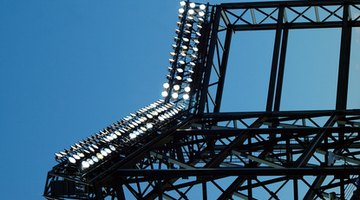How to Test an HID Bulb
Metal halide bulbs, high-pressure sodium bulbs and mercury lamps make up the family of high-intensity-discharge (HID) lighting. A ballast serves as a lamp starter and regulates power to the light. The ballast assembly consists of a transformer, capacitor and lamp starter sized for the specific type of lamp.

Tip
The light fixture nameplate data specifies the original ballast assembly and not necessarily the existing ballast arrangement.
Warning
Lock out or secure power to the light fixture before servicing the ballast.
-
Examine the bulb for signs it has burned out. A mercury HID bulb exhibits a blackening at the end of the arc tube. High-pressure-sodium lamps and metal-halide lamps do not exhibit obvious symptoms when power is off.
-
Check the specifications on the ballast. An incorrect lamp-and-ballast combination will exhibit the same symptoms as a bad bulb. If the bulb is rated at 100 volts and 150 watts, the ballast characteristics must match.
-
For high-pressure sodium lamps, use a known good bulb to first ensure the ballast and starter are operable. Once verified, insert the suspect bulb and test operation.
The Drip Cap
- Metal halide bulbs, high-pressure sodium bulbs and mercury lamps make up the family of high-intensity-discharge (HID) lighting.
- If the bulb is rated at 100 volts and 150 watts, the ballast characteristics must match.
- For high-pressure sodium lamps, use a known good bulb to first ensure the ballast and starter are operable.
Writer Bio
Damon Hildebrand is a retired U.S. Navy veteran. He has more than 15 years within the oil and gas industry in both technical and managerial positions. Hildebrand has been a technical writer and communicator for the last four years. He is a certified specialists in lubrication and tribology, as well as a certified maintenance and reliability professional.
Photo Credits
- stadium lights image by itsallgood from Fotolia.com
- stadium lights image by itsallgood from Fotolia.com
More Articles



